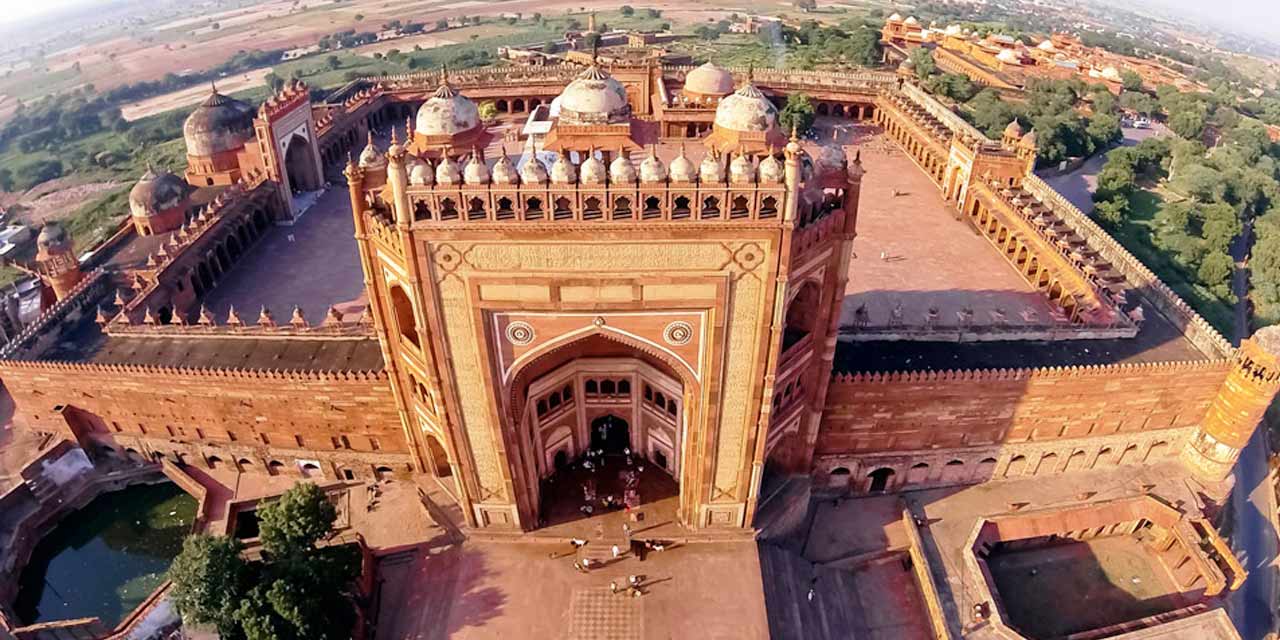Fatehpur Sikri Agra Entry Fee
- 50 per person for Indians
- 610 per person for Foreign tourist
Fatehpur Sikri Fort Agra Phone
N/A
Rating:  | 4/5 stars
| 4/5 stars
Based on total 35 reviews
Fatehpur Sikri Fort Agra Address: Agra, Uttar Pradesh, 283110, India
Agra Tour Packages
Agra Tour PackagesFatehpur Sikri Fort Agra Timings
| Day | Timing |
|---|---|
| Monday | 6:00 am – 6:00 pm |
| Tuesday | 6:00 am – 6:00 pm |
| Wednesday | 6:00 am – 6:00 pm |
| Thursday | 6:00 am – 6:00 pm |
| Friday | 6:00 am – 6:00 pm |
| Saturday | 6:00 am – 6:00 pm |
| Sunday | 6:00 am – 6:00 pm |
Note: Fatehpur Sikri Agra is opens Sunrise to sunset
Links: Website | MapFatehpur Sikri Agra Entry Tickets Prices
| Tourist Type | Amount (Rs.) |
|---|---|
| Domestic/Indian | 50/- |
| Entry fee for Indians and citizen of SAARC and BIMSTEC countries | 50/- |
| Foreign tourist | 610 |
| Entry Below (Children Below Age 15) | Free |
Fatehpur Sikri Fort is a UNESCO World Heritage Site and a hidden gem on the outskirts of Agra. It was built by the Mughal emperor Akbar, and it’s a beautiful reflection of the architecture of the era.
The fort is an entire complex of historical Mughal monuments from when it was the capital. It’s known for its red sandstone buildings, intricate carvings and expansive gardens.
Fatehpur Sikri Fort complex boasts an architectural blend of Islamic, Hindu and Persian styles. You can explore several monuments like Jodha Bai’s Palace, Panch Mahal and the tomb of Salim Chishti within the fort. Each place has its own allure and significance.
Agra Fatehpur Sikri Fort is a symphony of history, culture and architecture. The magnificence of this historical destination can put anyone in a state of trance. You might even find hidden corners and secret chambers whispering stories from the past.
The fort is an architectural marvel that transports you back in time to the Mughal grandeur. And it stands atop a rocky ridge overlooking the vast expanse of the surrounding countryside.
Where is Fatehpur Sikri Fort?
Fatehpur Sikri Fort is in Fatehpur Sikri region of Uttar Pradesh, India. It’s said to be the first planned city of the Mughals. It has several buildings for administrative, residential and religious purposes. Agra to Fatehpur Sikri Fort distance is 36 km.
Image Gallery of Fatehpur Sikri Fort Agra
History of Fatehpur Sikri Fort
Fatehpur Sikri Fort is an architectural legacy whose roots go back to the 16th century. Emperor Akbar found this town in 1571. A part of its name is derived from Sikri village, which existed here before the fort was constructed.
It was renamed Fatehpur Sikri (meaning the City of Victory) in 1573 after Akbar’s victory over Gujarat. And it became a military stronghold as well as a place for scholars, poets and artists to gather.
The grandeur of the fort, though, was short-lived. Fatehpur Sikri was the Mughal capital only for 15 years, from 1571 until 1585.
It had to be abandoned due to the prevailing unrest in the northwestern part of the country. By 1610, the entire Fatehpur Sikri was abandoned. Later, when the colonial rulers occupied Agra in the early 19th century, they established an administrative centre here.
Despite its brief period as a capital, Fatehpur Sikri Fort left an indelible mark on Indian history. Its architectural splendour continues to captivate visitors to this day.
And due to its historical and cultural significance, it was declared a UNESCO Heritage in 1986.
Architecture of Fatehpur Sikri Fort
Fatehpur Sikri Fort’s architecture is a magnificent amalgamation of varied artistic styles. It’s a grand canvas of the creativity of the Mughal architects and craftsmen.
The construction of the fort was primarily done using red sandstone, giving it a distinctive and captivating appearance. And the structures within are adorned with exquisite carvings.
It houses several palaces, mosques and other administrative buildings. And it showcases a unique fusion of Indian and Islamic architectural styles.
The entire complex is bordered by 6-km long defensive walls with several entryways built in. Tourists mostly enter through the Agra Gate.
Places to visit in Fatehpur Sikri Fort
1. Jodha Bai Palace – Jodha Bai Palace was the residence of Akbar’s favourite queen, Jodha Bai (also known as Mariam-uz-Zamani). And it’s a mirror of the respect and recognition she received. She was known for her grace, intelligence and strong influence on Emperor Akbar.
Wandering through Jodha Bai Palace, you can feel the grandeur of the queen’s daily life. It seamlessly integrates elements of Rajput and Mughal-style architecture.
2. Panch Mahal – Panch Mahal is another mesmerizing palace in the fort. It’s a five-storey structure that displays the artistic brilliance and engineering prowess of the Mughal artisans.
The palace holds a unique charm, and its design creates a graceful silhouette of the aesthetic structure that the palace is. Each storey is smaller than the lower one, and each is adorned with carved pillars and ornate balustrades.
3. Rang Mahal – Also called Pleasure Palace, Rang Mahal is one of the oldest structures in Fatehpur Sikri Fort Agra. It’s said that Akbar built this red sandstone palace for his wife and that Prince Salim was born here.
Its exquisite frescoes and decorative motifs were said to be used here for the first time. They have now faded with time, but the palace hasn’t lost its elegance and vibrance.
4. Diwan-e-Khas – Diwan-e-Khas is a grand hall that Emperor Akbar used to entertain his special and eminent guests. The interior has a fusion of Hindu and Islamic artistic influences. And it offers a glimpse into the fascinating royal court.
Diwan-e-Khas was where dignitaries, intellectuals and spiritual leaders held meetings with the emperor. You can still feel an aura of power and authority here.
5. Diwan-e-Aam – Diwan-e-Aam is another magnificent hall in the fort complex and a popular place to visit in Fatehpur Sikri. It was for Emperor Akbar to meet with his subjects and listen to their grievances. The focal point of Diwan-e-Aam is the elevated platform where Akbar sat on his throne.
The acoustics of the hall were carefully designed to ensure he could hear the voices of his subjects clearly.
6. Buland Darwaza – Buland Darwaza is a gateway in Fatehpur Sikri, which is known for its magnificence and architectural beauty. It’s 54 metres high, and it was built to commemorate Emperor Akbar’s triumphant victory over Gujarat.
The design of Buland Darwaza is a maze of intricate carvings, delicate latticework and complex geometrical patterns. And it still stands as a symbol of power, authority and conquest. It also offers a breathtaking view of the surrounding landscape from its galleries.
7. Jama Masjid – Jama Masjid is one of the largest mosques in India and an architectural masterpiece built within the fort. But visiting the mosque isn’t just an architectural exploration. It’s also a journey of introspection and cultural understanding. It’s for people to reflect and pray to get what they deserve.
8. Tomb of Salim Chishti – Salim Chishti’s tomb is another among the spiritual places in the fort of Fatehpur Sikri. It’s a pristine white marble mausoleum dedicated to Sufi saint Salim Chishti.
It's a symbol of devotion and faith, adorned with delicate latticework and intricate carvings. People from all walks of life come here to pay homage to the saint. Locals believe that visiting the tomb fulfills all your wishes.
9. Birbal’s House – Birbal’s House belonged to Akbar’s trusted advisor, Birbal. It’s a place where many intellectual debates, artistic pursuits and meaningful conversations thrived in the past. And it’s a reminder of Birbal’s invaluable counsel to the emperor.
Visiting Birbal’s House is like stepping into the pages of a lesser-known part of Mughal history. It’s a witness to the bond between Emperor Akbar and his trusted advisor.
10. Daulat Khana – Daulat Khana (also known as Khwabgah) is the most beautiful building in the fort complex. It was the private palace of Akbar for rest and contemplation. It's one of the most well-planned buildings in Fatehpur Sikri.
It had a bedroom, a personal library and a small bathroom. It was connected to the offices (Daftar Khana) and other palaces. Daulat Khana was both comfortable and opulent. And its design and architecture reflected the luxury and lifestyle of the Mughals.
11. Anup Talao – Anup Talao is a magnificent, ornamental pool near Daulat Khana. It’s a red sandstone structure with an elevated platform and viewing and seating places around it. And it acted as a private retreat for Akbar to admire the beauty of the place.
It’s believed that the tank was once filled with copper, silver and gold coins that shimmered under the sun.
12. Hiran Minar – Hiran Minar is a 21-metre-high tower built during the reign of Emperor Akbar. He built it as a memorial to a beloved pet elephant named Hiran. This tower is built over an octagonal platform standing on a square base, and from its top, you can get panoramic views of the area.
It’s believed that the queens and royal women used Hiran Minar to watch ongoing games. It’s also believed that it served as a milepost for night travellers.
Other Things to do at Fatehpur Sikri Fort
1. Learning the history – You can hire a guide and take guided tours of the entire fort complex in Fatehpur Sikri. With a knowledgeable guide, you can go deep into the historical significance and importance of Fatehpur Sikri.
A guided tour will also provide insights into the lives of the Mughal rulers and the cultural and religious aspects of Mughal era life. You may even get to listen to captivating tales behind the fort’s construction (and abandonment).
2. Enjoying evening views – As the day draws to a close, you can witness the magnificent fort bathed in the soft golden light of the setting sun. The red sandstone silhouette creates a mesmerising sight as you walk in its shadow.
Walking through its desolate corridors, you’ll find moments of serenity and a peaceful, magical ambiance to savour.
3. Shopping for souvenirs – While you’re in Fatehpur Sikri, also make sure you explore the local markets surrounding the fort. You’ll find several shops selling local handicrafts, vibrant textiles and embroidered fabrics.
Another interesting souvenir to take back home is perfume. Attars (perfume oils) made from traditional aromatic ingredients are a must-buy. Mughal-style jewellery, ceramic items and miniature paintings are a few other things you can buy.
Fatehpur Sikri Fort Timings and Entry Fees
Fatehpur Sikri Fort is open every day, throughout the year. And Fatehpur Sikri Fort opening time is from sunrise to sunset.
Fatehpur Sikri fort ticket is ₹50 per person for Indian citizens and SAARC and BIMSTEC country visitors. For other foreign nationals, the entry fee is ₹610. For children below 15 years, entry is free. Audio guides (charged extra) are also available upon request.
Best time to visit Fatehpur Sikri Fort
The best time to visit Fatehpur Sikri Fort is in the winter season (from November to February). During winter days, the weather is the most pleasant to explore the fort complex properly. Visit it during the morning or late afternoon hours for a comfortable experience.
Time to explore Fatehpur Sikri Fort
Fatehpur Sikri Fort is a vast complex of residential and administrative buildings. It’s spread across a large area with several halls, palaces and other places to visit. So, you should have at least 2-3 hours to explore all the corners of the fort.
Things to keep in mind when visiting Fatehpur Sikri Fort
- Tickets are available near Diwan-e-Aam gate.
- Licensed guides are available near the ticket counter.
- CNG buses run from car parking to Diwan-e-Aam.
- Carry your identity card.
- Wear comfortable footwear.
- Keep a hat and sunglasses.
- Carry a bottle of water.
- Apply sunscreen creams.
- Take a guided tour for the best experience.
- Avoid interacting with hawkers and touts.
How to reach Fatehpur Sikri Fort?
The distance of Fatehpur Sikri from Agra Fort is 36 km. It’s about 35 km from Idgah bus stand and 36 km from Agra Cantt railway station. A small Fatehpur Sikri railway station is the nearest, 3 km away. And from Agra airport, the fort is 34 km away. The nearest international airport is in Delhi (215 km away).
And here are the different ways to reach Fatehpur Sikri Fort –
By train – You can take a train from Agra to Fatehpur Sikri railway station. It’s a small station 3 km away from the fort. From the station, auto-rickshaws are available.
By bus – Buses are also available from Agra to Fatehpur Sikri. The bus stand is about 3 km away from the fort. You can take an auto-rickshaw from the bus stand.
By auto/e-rickshaw – You can also take an auto-rickshaw directly from Agra to Fatehpur Sikri Fort. They’re available in all parts of Agra.
By cab/taxi – A cab or taxi is the best way to visit Fatehpur Sikri. You can book one from the top car rental companies in Agra and explore the fort complex and other nearby places easily.
FAQs about Fatehpur Sikri Fort
Explore all the popular sightseeing places of Agra by booking a Agra Tour Packages with us. At Agra Tourism, a division of Holidays DNA, we offer personalized packages that are tailor made for you. To know more about our offerings, please fill the Contact Us form.





